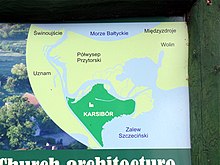Karsibór
Karsibór (German Kaseburg , also Caseburg ) is a part of the municipality Świnoujście (Swinoujscie) in the West Pomeranian Voivodeship , Poland . Karsibór is located on the island of the same name on the Szczecin Lagoon, which was part of the island of Usedom until the 19th century.
history
A coin from the year 718 was found near the village, which is considered to be the oldest datable find on the island of Usedom. The place was first mentioned in 1242, when the Dargun monastery acquired ownership rights here and in neighboring Garz . The monastery established a bailiwick in Kaseburg . In addition to Kaseburg, the towns of Woitzig , Faulensee and Swine belonged to it. After the Reformation was introduced in Pomerania in 1534 and the subsequent secularization , the Kaseburger Hofmeisterei was subordinated to the ducal office in Wolgast . Kaseburg also belonged to the Wolgast Synod until 1720.
After the Swedish army landed near Peenemünde during the Thirty Years' War in 1630 , King Gustav II Adolf of Sweden is said to have moved into his accommodation in the Kaseburg rectory between 14 and 19 July. When the island of Usedom came to Swedish Pomerania in 1648 after the Peace of Westphalia , the Kaseburg estate came to Johan Axelsson Oxenstierna . The Swedes had a shipyard built near Kaseburg in the middle of the 17th century, which got its wood from the Kaseburg Heath . The shipyard closed again after the trees were cut down.
With the construction of the Kaiserfahrt , the eastern part of the island of Usedom was separated with Kaseburg and became a separate island. During the Second World War , a port for submarines and speedboats was built directly on the Kaiserfahrt. The Navy's 4th training fleet was stationed here in 1944 . The remains of the demagnetization system can still be seen today .
After the Second World War , Kaseburg came to Poland . The place and the island were renamed Karsibór , which comes close to the name Carisubour from the first mention, which should mean beautiful forest . In 1966, the single-lane Piastowski Bridge was completed over the Stara Świna ( Old Swine ), which connects Karsibór with the island of Wolin. The bridge was rebuilt with two lanes between 2011 and 2012, the old bridge was demolished in 2013. A bus line has been set up from Świnoujście.
Attractions

- Church of St. Mary, from the 15th or 16th century, rebuilt in 1826 according to plans by Karl Friedrich Schinkel - the oldest building in today's Swinoujscie city
- former rectory where Gustav II Adolf is said to have slept in 1630
- Old German cemetery, one of the few cemeteries in old Pomerania that is still well preserved. A special feature are the wrought iron grave borders, unfortunately heavily decimated by scrap thieves in recent years.
- Observation tower in the Karsiborska Kępa bird sanctuary
- Pier of the Kaiserfahrt in the south of the island
literature
- Dirk Schleinert : The history of the island of Usedom . Hinstorff Verlag, Rostock 2005, ISBN 3-356-01081-6
Individual evidence
- ^ Martin Kaule, Baltic Sea Coast 1933-1945 with Poland and the Baltic States: the historical travel guide , Berlin 2011, p. 122. ISBN 978-3-86153-611-6
- ↑ Tourist Map - Wollin Island and Surroundings, Warsaw 2012
Web links
Coordinates: 53 ° 51 ′ 14 " N , 14 ° 18 ′ 44" E

